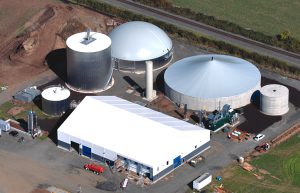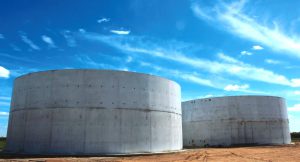BioCycle October 2013, Vol. 54, No. 10, p. 12
Junction City, Oregon: Commercial Organics Digester On Line
JC-Biomethane (JcBio) in Junction City began receiving loads of postconsumer food waste and other substrates over the summer, and the digester started producing renewable gas and generating electricity this fall. The facility has capacity to codigest 25,000 tons/year of ogranics, including commercial organics (including material from the Portland metro area), regionally sourced grass straw and food/beverage industry residues (e.g., fruit and vegetable waste, spent yeast/grains, recycled cooking oils). Designed and managed by Dean Foor of Essential Consulting Oregon, LLC, the plant is expected to produce 12,250 MW hours of electricity annually. JcBio is the first biogas plant in the U.S. to employ a Swiss-made Hybag Bioseparator to remove hard contaminants like metal and plastic from the waste, use ozone for odor control, and an anaerobic digester designed and built by FormTec GMBH, a Germany-based company.Funding sources include a $2 million incentive from Energy Trust of Oregon, a $1 million Oregon Business Energy Tax Credit pass-through payment, federal funding through the American Recovery and Reinvestment Act of 2009 and federal tax credits. Coproducts include a liquid fertilizer that is utilized by a neighboring farm; digested fiber is composted. Excess heat recovered from the cogeneration unit is available for future use by nearby businesses. Electricity is sold to Portland General Electric through a wheeling arrangement with the Blachly-Lane County Cooperative Electric Association and a transmission agreement with Bonneville Power Administration.
Sacramento, California: Federal/State Dairy Digester Working Group
In 2011, the U.S Environmental Protection Agency, U.S. Department of Agriculture and the California Department of Food and Agriculture (CDFA) convened the California/Federal Dairy Digester Working Group. This partnership of state, federal and local agencies, academia, industry, nonprofits and utilities came together to identify and remove barriers to the development and permitting of dairy digester systems in California. The work has culminated in specific recommendations to reduce the economic, technical and regulatory hurdles currently in place, making digester systems more feasible in the state, which has approximately 1.7 million cows producing more than 3.6 million dry tons/year of manure. In mid-September, the Digester Working Group issued a joint solicitation for dairy digester concept proposals (due November 1). Proposers were asked to include details on development, installation and operation of dairy manure digester and codigester projects as well as processes for the treatment and disposal of waste streams from the digester operations to address environmental impacts. Funding may be provided by various participating agencies of the Dairy Digester Working Group for proposals deemed most viable with the greatest measurable outcomes. Individual digester projects will have to qualify for funding on a case-by-case basis and projects can potentially receive financial support from multiple participants.
To assist in identifying potential funding sources, a Funding Matrix document was created. The California Governor’s Office of Business and Economic Development (Go-Biz) will serve as the point of contact for the consolidated funding process. And an initiative is underway to streamline the permitting process for dairy digesters; participating agencies include Cal EPA, CDFA, a regional water quality control board and a regional air district. www.cdfa.ca.gov/EnvironmentalStewardship/
Albany, New York: Digesters Are 21st Century Ag Equipment
In late July, New York Governor Andrew Cuomo signed S.4770, a bill that ensures that on-farm anaerobic digesters are properly categorized as agricultural facilities for property tax assessment purposes. State Sen. Patrick Gallivan, a key sponsor, was quoted in The Daily News that “the future of agriculture will be defined by high-tech innovation and the ability to apply new technologies in an increasingly competitive marketplace. …. This law simply ensures that anaerobic digesters will be recognized for what they are — 21st Century agricultural equipment.” The bill was introduced because some interpretations of New York State tax law caused digesters to potentially be classified as energy production facilities, thus subjecting them to much higher property tax assessments. A similar issue, but at the municipal level, was raised among farm digester operators in Vermont last fall.
Cardington, Ohio: Livestock Company Officially Opens Digester
Ringler, a third-generation livestock company, held an open house to celebrate the grand opening of an anaerobic digestion renewable energy facility on its farm in Cardington. The digester system, supplied by quasar energy group, manages organic waste from on-site hog operations along with organic residuals from the region. “As the third-generation Ringler to run our family business, I am always focused on making decisions that will secure our farm’s sustainability,” said Alex Ringler at the open house. “I want to pass this operation on to our fourth generation, my sons. Anaerobic digestion is going to play a big role in securing this future and I enjoy being at the forefront of something new and exciting.” Added David Daniels, director of the Ohio Department of Agriculture: “Ringler farm’s new anaerobic digester is a great investment in the local community and for the agriculture industry as a whole. When farmers embrace changing trends and progressive ideas, they improve their operations, increase profitability, while at the same time protecting the environment and creating economic activity that maintains the state’s $105 billion food and agriculture industry.”
The digester has tank capacity of 750,000 gallons, with anticipated throughput of 42,000 wet tons/year of manure and off-farm substrates. The project is funded in part through the USDA Rural Energy for America Program (REAP), as well as through First Farmers Bank & Trust. Electricity from an 800 kW engine is used to power on-site farm operations and sold to Consolidated Electric. Phase two of the project will include construction of a compressed natural gas fueling station that will power Ringler’s fleet of more than 40 trucks. Anticipated CNG production from biogas is approximately 550 gasoline gallon equivalents (gge) per day. The quasar/Ringler collaboration has begun construction of a second anaerobic digester in Fairborn, Ohio. The project is scheduled to be operational before the end of the year.
Pickett, Wisconsin: Large-Scale Dairy Digester
Rosendale Dairy, Wisconsin’s largest dairy farm, broke ground on the construction of a 1.4 MW anaerobic digester in July. The $7 million project is expected to process 240 tons/day of manure from the dairy’s 8,500 cows. It is being funded by the University of Wisconsin-Oshkosh (UW-Oshkosh) Foundation, and is a continuation of a partnership formed in 2011 between UW-Oshkosh, the Foundation and BioFERM Energy Systems, the technology provider. A public education center will be built at the Rosendale Dare, along with a research laboratory for UW-Oshkosh students and staff. This is the third digester developed by the partnership; the first is the UW-Oshkosh dry fermentation facility, located on the university’s campus, which processes food waste, crop residuals and other organics. The second digester, located at Allendale Farm, is using BioFERM’s modular digester, EUCOlino. Electricity generated by the Rosendale digester will be sold to the grid through an arrangement with Madison-based Alliant Energy Corp. UW-Oshkosh will utilize the carbon credits from the renewable power generated at the site to help it fulfill its climate change emission reduction commitment.
Newport Beach, California: Marketing Push For Renewable Natural Gas Fuels
In the front section of the New York Times on Sunday, October 4, we saw a full-page advertisement for Redeem™, “The First Renewable Natural Gas Made From Organic Waste And Available As Commercial Vehicle Fuel.” The ad caught our attention as it isn’t everyday we see “organic waste” displayed so prominently. The ad was placed by Clean Energy Fuels Corp., a North American provider of natural gas fueling for transportation. In a press release dated October 3, Clean Energy stated that it will be the first company to commercially distribute a renewable natural gas vehicle fuel, called Redeem, made from organic waste streams at landfills, large dairies and sewage plants, directly to fleets around the country and at the 35 public Clean Energy stations throughout California. Andrew J. Littlefair, president and CEO of Clean Energy, noted that the company’s goal is to “produce and distribute 15 million gallons of Redeem in our first year which can make significant progress towards achieving California’s climate change goals and prove that this is a viable, cleaner and abundant alternative fuel source for our future.” Clean Energy is making a significant investment in a natural gas fueling infrastructure, including 400 fueling stations throughout the nation, and in the development of multiple biomethane production facilities that will produce Redeem. Today, Clean Energy is producing Redeem at biomethane production facilities in Dallas, Texas and Canton, Michigan, and is constructing a third facility in Millington, Tennessee. Clean Energy also sources biomethane from third parties to market and distribute as Redeem vehicle fuel.












